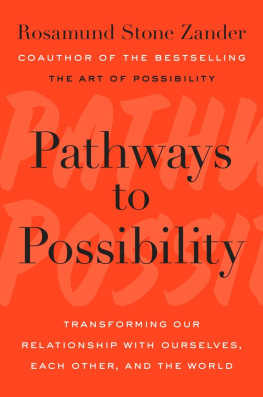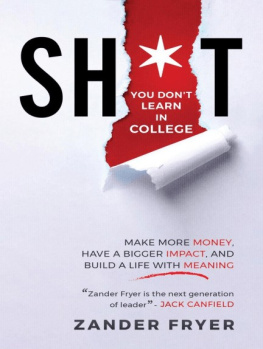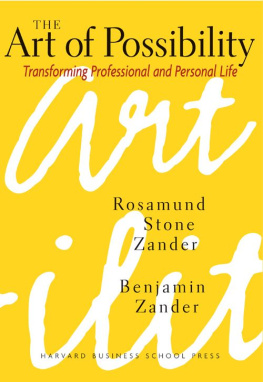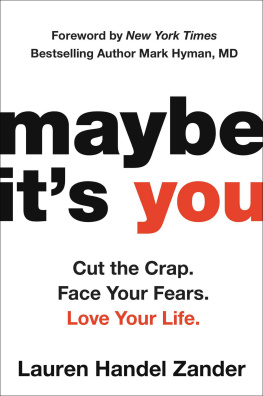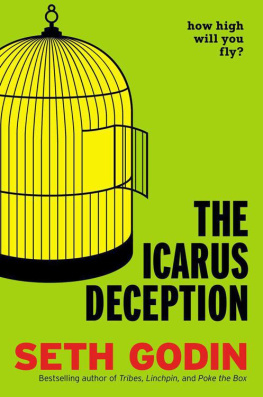Penguin supports copyright. Copyright fuels creativity, encourages diverse voices, promotes free speech, and creates a vibrant culture. Thank you for buying an authorized edition of this book and for complying with copyright laws by not reproducing, scanning, or distributing any part of it in any form without permission. You are supporting writers and allowing Penguin to continue to publish books for every reader.
While the author has made every effort to provide accurate telephone numbers, Internet addresses, and other contact information at the time of publication, neither the publisher nor the author assumes any responsibility for errors or for changes that occur after publication. Further, the publisher does not have any control over and does not assume any responsibility for author or third-party Web sites or their content.
Introduction
If you do not change direction, you may end up where you are heading.
L AO T ZU
I N THE DE CADE AND a half since the publication of TheArt of Possibility, its ideas and stories have evolved into something like a movement. People from multiple walks of life have taken up the practices and embedded them in their workplaces or in their family life. We get letters of gratitude from many with whom we have no connectionthe producer who attributes the existence of the wonderful film As It Is in Heaven to reading The Art Of Possibility, a candidate for public office who whispers that he keeps it by his bedside as his guide. A company that was the only one in its industry that went cash positive in the 20079 downturn attributes its success to the concepts and messages in The Art of Possibility. We received a newspaper article in the mail that informed us that President Uribe of Colombia offered the book as his only gift to President Chvez of Venezuela in tense times, and we heard from many a parent grateful for being able to get on a more life-enhancing track with a son or daughter.
We cast out a pebble in a pond, and we are unable to see the extent of the ripples although we know they go far. In those intervening years, Ben and I, the authors of TheArt of Possibility, havent stood still. Nor has the earth, for that matter. It has spun through some sixty-three billion miles of space in the interim, sweeping up new information from the universe and sending out its own messages. Meanwhile, Bens activities have accelerated, as he has presented our model of Possibility to groups and institutions on every continent. His astounding energy seems to gather its resonance from the world around him, like fine crystal emitting harmonics at the touch of a finger.
While Ben has been circling the globe, I have been doing a deep dive into the inner world of our being, on a mission to discover how we may continue to grow beyond what we settle for as maturity. Most of us associate growing up with reaching a certain age, or taking on responsibilities, or passing our wisdom and resources on to the next generations. But I believe that when we become aware of patterns in our behavior, when we learn to identify and rewrite the stories that give us our identities, we will gain passage, at any age, into a new phase of adulthood. In this territory of maturity, where old fear-based patterns no longer hold us back, we will, I wager, do what we now think of as remarkable, even magical, things. In defiance of the adage You Cant Change People, people around us will change in our presence, step into productivity and contribution, and flourish. In this further phase of adulthood, we might well be agents for powerful action in the collective interest, helping rain forests to renew themselves, children to dedicate themselves to worthwhile pursuits, and relationships between nations to thrive. And further, when we become aware and adept at putting our outdated stories out of their misery and creating new ones, we have a pretty good chance of experiencing that sense of profound and ecstatic connection to the universe that monks and shamans talk about. Its to understanding and articulating this vision of human growth and expansion that I have dedicated the last fifteen years.
The mission of The Art of Possibility was to teach people to distinguish two broad categories of approaches to life: one is the everyday attitude we call the downward spiral, with all its joys and sorrows, triumphs and losses. The second approach we named radiating possibility, and it is the attitude that life is a story we tell and live. The underlying assumption of the downward spiral is that life is all about survival, where you stand to win big if you are clever enough, get the right education, meet the right people, and make the best choices. But of course, chance and circumstances being what they are, in the downward spiral you are always faced with the fearful prospect that you might also lose. Your money may run out, the power you once enjoyed may disappear overnight, and the love you counted on may wane, or indeed be snatched away.
In the second approach, radiating possibility, you can change your story at any time to be better adapted to the magnificent flow of the way things are, and the world will reflect the change in you, opening doors and showing you a path to where you want to go and what you want to do. This outlook gives rise to joy, love, and gratitude, leaving room for fear only in circumstances where feeling fear will mobilize you best to avoid an immediate threat to life and limba truck bearing down on you, for instance; not the prospect of losing someones affection or being fired from your job.
So the first outlook, the downward spiral, is about the struggles over winning and losing, and the second, radiating possibility, is about creating the world in which you want to live. Each one is accompanied by its own distinctive postures, emotions, and expression. Each is a way of being. If, after spending time with TheArt of Possibility, people were able to distinguish between the two attitudes through doing the practices, Ben and I felt we had accomplished our mission. At that point readers had a choice of perspective, and as a rule they chose to live in Possibility.
The current book, Pathways to Possibility, is firmly situated in the realm of possibility, but its mission is not focused on the distinction between the two attitudes addressed above. Your experience may deepen if you have read or choose to read The Art of Possibility, but it is not a necessary starting point for your journey through this manuscript. The mission of this book is to illuminate new pathways for growth. Throughout history, we human beings have bumped up against glass ceilings that have stopped us in our tracks and prevented us from going any farther, even in our imaginations. And then come the breakthroughs. Someone beats the record of the four-minute mile, and the door swings wide open for others. A black woman refuses to go to the back of the bus, and the whole of America wakes up, cheering or fighting, and from then on everything is different.

